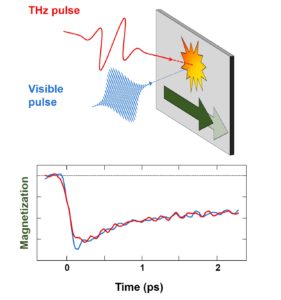
Researchers of the Collaborative Research Center TRR227 “Ultrafast spin dynamics” at Freie Universität Berlin found that the magnetization of laser-excited ferromagnetic iron undergoes the same dynamics independent of the wavelength of the driving laser pulse. Therefore, it is just the amount of heat dumped into the electrons at a given moment that determines the course of the demagnetization.
When a ferromagnet such as iron is heated, its magnetization decreases because the ordered electron spins (which can be thought of as little compass needles) are forced to fluctuate more strongly. Heating of the magnet can be done extremely fast by a femtosecond laser pulse. Iron and nickel are known to decrease their magnetization in a time as short as 100 fs. This ultrafast demagnetization provides fundamental insights into the coupling of electrons with their ordered spins.
“It is important to realize that the laser pulse initially drives the electrons into a state that cannot be described simply by an increased temperature. So far, it was unclear to which extent the highly nonthermal nature of this state affects the subsequent spin dynamics.” says Dr. Alexander Chekhov from Freie Universität Berlin.
To answer this question, the researchers excited ferromagnetic iron with either visible or terahertz pump pulses (see figure). While the visible photons (energy 3.1 eV) induce a highly nonthermal state, the about 1000 times less energetic terahertz photons (4.1 meV) just increase the electron temperature.
“Remarkably, for both pump pulses, we find that the sample magnetization undergoes an identical evolution down to the time resolution of 130 fs.”, Chekhov explains. “This means that ultrafast magnetization dynamics is predominantly determined by the amount of heat dumped into the electrons at a given moment, no matter how highly these electrons are excited.”
The researchers believe that, besides their fundamental relevance, their insights are also excellent news for various applications involving pulsed lasers. Examples include all-optical magnetic-information writing in metals and the spintronic generation of terahertz electromagnetic pulses: They can be driven with any laser wavelength.
Original publication:
A. L. Chekhov, Y. Behovits, J. J. F. Heitz, C. Denker, D. A. Reiss, M. Wolf, M. Weinelt, P. W. Brouwer, M. Münzenberg, T. Kampfrath
Ultrafast Demagnetization of Iron Induced by Optical versus Terahertz Pulses
Phys. Rev. X 11, 041055 (2021)